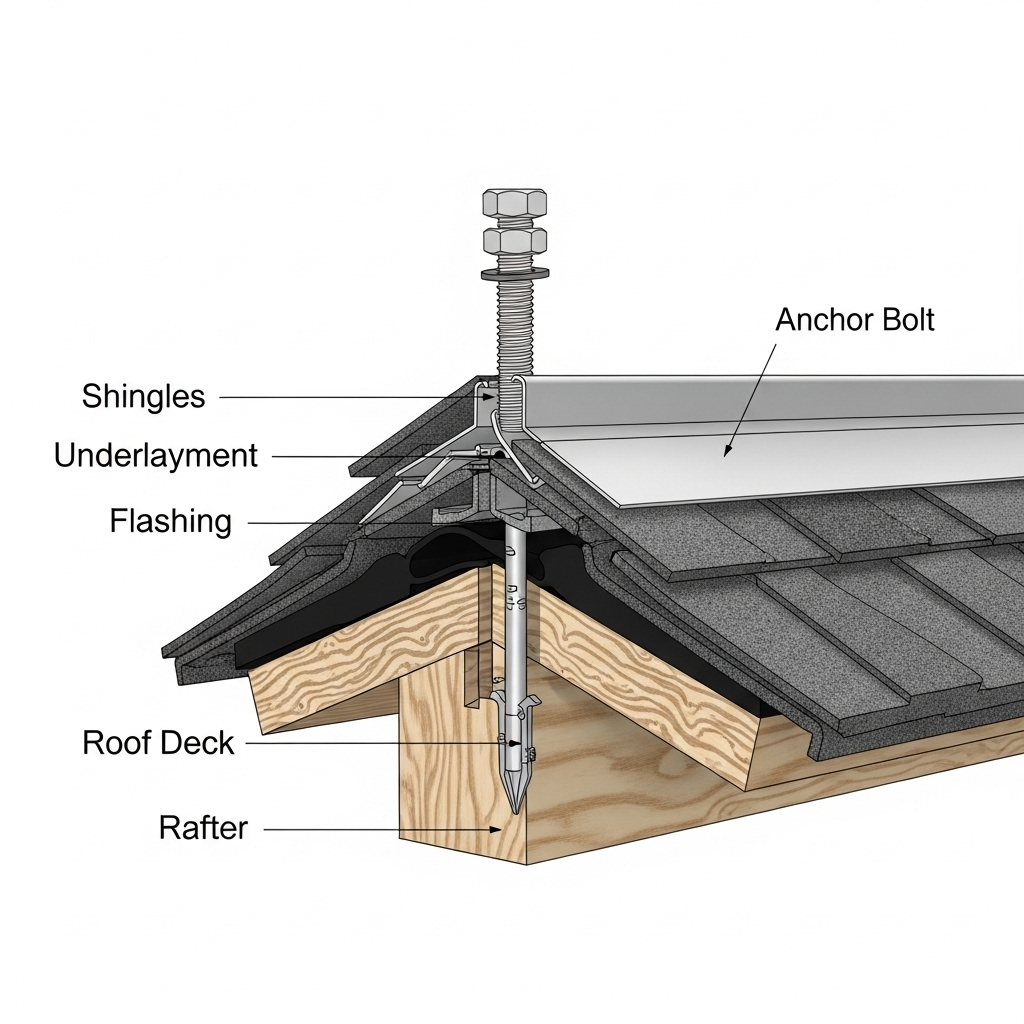A rooftop solar installation is only as strong as its weakest link. While panels and inverters often get the spotlight, the mounting system is the foundation that ensures decades of reliable performance. Three pillars support this foundation: robust anchoring, watertight flashing, and long-term corrosion control. This installer’s checklist provides a systematic approach to verify each component is installed correctly, ensuring every rooftop system is safe, durable, and leak-proof.
Securing the Foundation: The Anchor Checklist
Anchors are the critical connection point between the solar array and the building structure. They transfer all static and dynamic loads, including the weight of the equipment and the forces of wind and snow, directly to the roof rafters. Failure here is not an option.
Verifying Structural Integrity
Before drilling the first hole, a thorough roof assessment is necessary. This involves locating and confirming the spacing, size, and condition of the rafters. For older structures or complex projects, a professional structural analysis is a prudent investment. As noted in system design best practices, costs for geological surveys or structural analysis are a key part of ensuring a project's viability. The goal is to anchor directly into solid structural members, never just the roof decking, which lacks the strength to handle the loads.
Selecting the Right Hardware
The choice of anchor depends on the roof type and local environmental conditions. Lag bolts are a common choice for standard asphalt shingle roofs, while specialized hardware is required for tile and metal roofing. Material selection is equally important. Stainless steel hardware offers superior corrosion resistance, particularly in coastal or humid environments. Galvanized components can be a cost-effective alternative, but their compatibility with other materials must be carefully managed.
Proper Installation Techniques
Correct installation technique is non-negotiable. Always drill a pilot hole of the appropriate size to prevent the rafter from splitting. Apply a high-quality sealant into the pilot hole before inserting the anchor to create the first layer of water protection. Use a calibrated torque wrench to tighten each anchor to the manufacturer's exact specifications. Over-tightening can crush the wood and compromise its holding strength, while under-tightening can allow for movement that leads to component failure.
Creating a Watertight Seal: The Flashing Checklist
Flashing is the primary defense against water intrusion at every roof penetration. A single failed seal can lead to thousands of dollars in water damage, making this step one of the most critical in the entire installation process.

Choosing the Correct Flashing Type
Flashing is not a one-size-fits-all product. Different roof materials require specific flashing designs. For asphalt shingles, L-foot or standoff flashing systems are common. These are designed to slide under the upper course of shingles. Tile roofs require specialized tile hooks that replace a tile, while metal roofs often use mounts with EPDM rubber gaskets that create a compression seal.
Installation Best Practices
The core principle of flashing is to work with gravity to shed water. Each piece of flashing must be installed in a layered fashion, with the upper edge tucked securely beneath the roofing material above it. This ensures that water flows down and over the flashing, not under it. Check that the seal around the anchor is complete and that there are no gaps where water could penetrate. A properly installed flashing system should be virtually invisible and completely integrated with the roofing plane.
Ensuring Longevity: The Corrosion Control Checklist
Corrosion is a silent threat that can degrade a mounting system over time, compromising its structural integrity. The most common form on a rooftop is galvanic corrosion, which occurs when two different metals are in direct contact in the presence of an electrolyte, such as rainwater.
Understanding Galvanic Corrosion
When dissimilar metals like aluminum racking and galvanized steel bolts are connected, they can form a small battery. One metal becomes the anode and corrodes at an accelerated rate, while the other becomes the cathode. This process can weaken critical connections, leading to potential system failure. The risk is highest in wet or salt-spray environments.
Material Selection and Compatibility
The simplest way to prevent galvanic corrosion is to use materials that are compatible. High-quality mounting systems often use aluminum rails with stainless steel hardware, as this combination has a low potential for galvanic corrosion. According to a report by the IEA, ensuring rooftop systems can operate for up to 20 years is critical, which necessitates high-quality equipment and installation practices. Unlocking the Economic Potential of Rooftop Solar PV in India highlights that long-term durability is essential. Maintaining the physical integrity of the mounting system is just as crucial as monitoring its electrical output. A robust structure ensures the long-term viability and performance of your solar and storage system. For a deeper look into system monitoring, you can review this ultimate reference on solar storage performance.
Isolation and Prevention Techniques
When using dissimilar metals is unavoidable, they must be electrically isolated. This can be achieved with non-conductive plastic or rubber washers, gaskets, or coatings that prevent direct metal-to-metal contact. Regular inspections, especially during annual system check-ups, should include looking for signs of corrosion like discoloration or pitting around fasteners.
Consolidated Pre-Work Checklist
Use this table as a final verification before completing the mechanical installation. It summarizes the most critical checkpoints for a secure and durable roof mounting system.
| Component | Checkpoint |
|---|---|
| Anchors | Rafters located and confirmed to be in good condition. |
| Anchors | Correct anchor type and material selected for the roof and environment. |
| Anchors | Pilot holes drilled to the correct depth and properly sealed. |
| Anchors | All fasteners tightened to manufacturer torque specifications. |
| Flashing | Flashing type matches the specific roof material. |
| Flashing | Flashing is layered correctly with roofing materials to shed water. |
| Flashing | A complete, watertight seal is confirmed at all penetration points. |
| Corrosion | All hardware and component materials are galvanically compatible. |
| Corrosion | Dissimilar metals are properly isolated with non-conductive barriers. |
| System | All equipment is fixed and installed securely to prevent theft or movement. |
Final Thoughts on Installation Excellence
A methodical approach to installation is what separates a good system from a great one. Paying close attention to the details of anchoring, flashing, and corrosion control does more than just meet code requirements; it ensures the system's safety, protects the customer's home from damage, and guarantees the longevity of the solar investment. The International Energy Agency emphasizes that as renewable energy integration grows, the quality and security of each installation become paramount. This focus on quality is the foundation of a reliable and sustainable energy future.
Frequently Asked Questions
What is the most common point of failure in rooftop solar mounting?
Improperly installed flashing is a leading cause of leaks. Even with a strong anchor, a poor seal will compromise the roof's integrity over time, leading to water damage. It is crucial that flashing is layered correctly with the shingles to ensure proper water shedding.
Can I use galvanized steel bolts with aluminum racking?
This is generally not recommended without proper isolation measures. Galvanized steel and aluminum are dissimilar metals that can cause galvanic corrosion when in contact with an electrolyte like rainwater. Using stainless steel hardware with aluminum components is a more reliable practice. If you must use them together, ensure a non-conductive washer or barrier separates them.
How do I know the correct torque for an anchor bolt?
The torque specification is provided by the mounting system manufacturer in their installation manual. It is critical to use a calibrated torque wrench to tighten hardware to these exact values. Over-tightening can damage the roof structure or the hardware, while under-tightening can lead to a loose connection that fails under load.
Is a structural engineer always required for a rooftop installation?
While not always mandatory for small residential systems on standard roofs, consulting a structural engineer is a highly recommended best practice. For older homes, roofs with unconventional framing, or in areas with high snow or wind loads, a structural analysis is a critical safety measure. Many local permitting authorities now require an engineer's stamp on the plans before issuing a permit.





Leave a comment
All comments are moderated before being published.
This site is protected by hCaptcha and the hCaptcha Privacy Policy and Terms of Service apply.